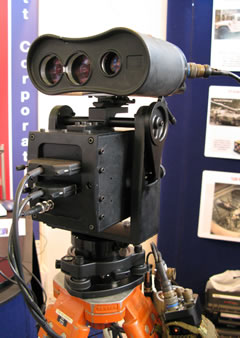Modern target acquisition systems comprising imaging, position measurement and rangefinding equipment and communications systems are integrated to provide rapid and accurate targeting information, automating target acquisitiona and fire coordination between combat and combat support units in a networked enable battlespace. These systems can also utilize target designators to mark and designate targets for attack by laser-homing or GPS guided weapons.
At Eurosatory 2008 Sagem Défense Sécurité introduced several systems addressing these capabilities. The company announced cooperation with L3 Communications (through its Communication Systems-West division) are cooperating to develop a new networked tactical information system for air-land targeting, designed as Real Time – Situational Awareness Airborne Targeting System (RT-SAATS). The new system unveiled at Eurosatory 2008, is designed to comply with NATO interoperability standards, linking ground soldiers and aircraft in inter-allied and inter-service operations. The system will be employed by a forward observer, enabled by the RT-SAATS to transfer to support elements such as aircraft and helicopters with real-time images of the situation or targets, with precise coordinates. The RT-SAATS ground segment will contain a JIM LR (Long Range) day/night multifunction thermal imager connected to a tactical terminal, a Rover Mini Tactical Common Data Link, transmitting data, images and video from the JIM LR to the airborne system. The airborne segment of the system will consist of a receiver and display system, which could be directly linked to the aircraft weapon control system, feeding target coordinates to be the aircraft’s navigation and attack system.
Sagem also presented a new artillery positioning and navigation unit (PNU) called Sigma 30, utilizing a ring-laser-gyro, explosion-resistant GPS (mad e by Rockwell Collins). The system is designed to support GPS guided weapons entering service with artillery units, including guns, mortars and rockets. Sagem is proposing PNU as an upgrade to current artillery targeting systems employed by the MLRS rocket units operating with the French, German, and Italian armies. A similar system, integrating the JIM thermal imaging system, GPS navigation system and target acquisition systems from Rockwell Collins were recently delivered to update the equipment used forward observers of the Royal Artillery. Sagem and Rockwell Collins are also cooperating to offer an advanced target acquisition system based on Rockwell Collins’ Rosetta joint fires digital targeting system. Rosetta provides dismounted forward observers and forward air controllers with all services supporting and managing Close Air Support (CAS) using machine-to-machine digital communications.
 The Kearfott Corporation partnering wit Israel’s Na-Or from the ITL Group, unveiled at Eurosatory 2008 a target acquisition system designed to meet the high precision standards required for engaging targets with GPS guided weapons, such as JDAM bombs and Guided Multiple Launcher Rocket System (GMLRS) rockets. Current targeting equipment is relatively slow to setup and inaccurate, in terms of precision targeting standards, since it aggregates setup and reading errors of mulltiple measurement systems, such as rangefinder, GPS, compass and tripod leveling. The Gyro-based Navigation and Target Acquisition System (GN-TAS) utilizes a ring-laser-gyro to stabilize and level the system, measuring accuracy based on inertial data as well as GPS using a powerful miniature computer developed for soldier modernization applications. The system is optimized for forward observers and Joint terminal attack controllers (JTACs), as well as special forces. The application is based on Keafort’s three-axis Monolithic Ring Laser Gyro inertial (MRLG) navigation technology, combined with GPS, and laser rangefinder and target acquisition optronic device integrated with computer display and navigation capability. Since the system uses self leveling and positioning, GN-TAS does not require sophisticated pedestal mount and can use compact tripod for operation, therefore simplifying man portable applications.
The Kearfott Corporation partnering wit Israel’s Na-Or from the ITL Group, unveiled at Eurosatory 2008 a target acquisition system designed to meet the high precision standards required for engaging targets with GPS guided weapons, such as JDAM bombs and Guided Multiple Launcher Rocket System (GMLRS) rockets. Current targeting equipment is relatively slow to setup and inaccurate, in terms of precision targeting standards, since it aggregates setup and reading errors of mulltiple measurement systems, such as rangefinder, GPS, compass and tripod leveling. The Gyro-based Navigation and Target Acquisition System (GN-TAS) utilizes a ring-laser-gyro to stabilize and level the system, measuring accuracy based on inertial data as well as GPS using a powerful miniature computer developed for soldier modernization applications. The system is optimized for forward observers and Joint terminal attack controllers (JTACs), as well as special forces. The application is based on Keafort’s three-axis Monolithic Ring Laser Gyro inertial (MRLG) navigation technology, combined with GPS, and laser rangefinder and target acquisition optronic device integrated with computer display and navigation capability. Since the system uses self leveling and positioning, GN-TAS does not require sophisticated pedestal mount and can use compact tripod for operation, therefore simplifying man portable applications.
A new electro-optical device from Elbit Systems is the MARS developed by ElOp electro-optical division. MARS is a compact thermal hand-held thermal imager utilizing an uncooled (microbolometer) thermal sensor with target acquisition capabilities. The system weighs less than two kg, including batteries and can operate continuously for eight hours.
A larger system using a cooled thermal imager is the CORAL, a dual FOV Thermal Imaging camera, based on Elop’s advanced, proven 3-5mm FPA InSb detector technology. In addition to the imaging functions, CORAL-CR supports target acquisition capabilities, by determining self positioning and detected target position. These capabilities are achieved by a laser range finder, a digital compass and a GPS which are mounted and boresighted together with the FLIR. The CORAL-CR has a 1:5 continuous optical zoom, high resolution, 3-5mm FPA InSb detector and advanced algorithms. Combined with the new PLDR, a lightweight laser designator developed at ElOp, observation and target acquisition systems become target designators – the most critical element in the kill chain. Weighing only 5.5 kg the PLDR can be attached to almost any target acquisition kit. This targeting system can designate targets to ranges up to 10 km.
The following topics are included in our Eurosatory 2008 focus:
-
Precision attack and Target Acquisition Systems
- Unmanned Aerial and Ground Systems (UAV/UGV)

















